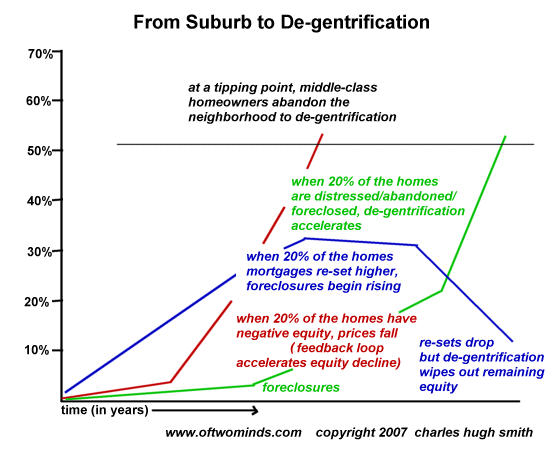

|
| weblog/wEssays archives | home | |
|
The Great Fall: How Suburbs De-gentrify to Ghettos (November 20, 2007) A disturbing number of mainstream media stories are documenting the appearance of inner-city plagues such as gangs, drugs and graffiti in what were recently middle-class suburbs. Long-time correspondents UKC. and Riley T. checked in with commentaries on the trends of de-gentrifation and wealth destruction. Here are UKC's comments: Remember how (many months ago) we were discussing how the some of the suburbs and exurbs might be hit harder by the housing downturn than others? The idea was that the empty houses would not be evenly distributed but would tend to accumulate in sink neighbourhoods. This means you could have a fully paid for house and still see its value reduced to zero as the area becomes unliveable. (emphasis added) You did a post on this. Well, its happening, here's a link I came across:This site's archives are chockful of entries on the housing bubble, going back to mid-2005 when this blog was launched. Just click on the "archives" links below and scroll right to the topic heading "Housing Bubble Watch." 2007 archives and 2005-2006 archives Here is a selection of the entries: (if you haven't read them before) How 4% of Mortgages Have Brought Down the Entire Market (August 21, 2007) The Mortgage Mess: The Soft Underbelly Beyond Subprime (April 10, 2007) Can 4% of Homeowners Sink the Entire Market? (February 21, 2007) Housing: 10% Decline May Trigger Financial Ruin (May 22, 2006) How Many Foreclosures Will Hit the Market? (May 1, 2006) Foreclosures and Financial Ruin: How Bad Will It Get? (April 26, 2006) The main drivers of de-gentrification, of course, are mortgages re-setting higher and falling prices, which reduce equity to a negative number. This removes the incentives (building wealth) which tend to keep homeowners at the debt wheel. Though various analyses of home equity have been made, Riley T.'s has the merit of considering those homes owned free and clear: The debt side of the real estate market has been getting a lot of ink. I thought a look at the asset side might be an eye opener.Given the forces at work and the evidence trickling in from the real world, I wonder if the Pareto Principle isn't at work here. If so, perhaps we can posit a quantitative model of de-gentrification: 1. When 20% of the homes in a neighborhood have negative equity, then prices begin falling rapidly. 2. When 20% of the mortgages in a neighborhood of rising negative equity re-set higher, then foreclosures rise rapidly. 3. Once 20% of the homes in a neighborhood are distressed, abandoned or foreclosed, then de-gentrification accelerates rapidly. 4. Should a critical inflection point (tipping point) be reached, the remaining responsible homeowners abandon the neighborhood to the forces of de-gentrification. This process can be illustrated by a chart such as this: 
De-gentrification is a highly disturbing possibility in neighborhoods with high numbers of distressed/foreclosed homes. Though I cannot locate any data on this topic, perhaps an academic researcher will be able to gather data and estimate the tipping points. Anthropological and sociological studies suggest populations begin shifting after relatively small changes in their demographics. These changes tend to gather momentum at certain points. With no other data or studies to go on, I would reckon homeowners' associations would be wise to draw a line in the sand at 20%--in other words, not allow more than 20% of a neighborhood's homes to degrade into abandoned, vandalized eyesores. How can neighbors stop this decline if they're not the owners? Simple: stop relying on the owners (the owner/lender could be mired in bankruptcy court for years, or be an overseas financial institution with no local office) and mow the lawn and care for the house themselves. Find decent tenants and then pressure the city for services. If the owner cannot be located (bankruptcy court is not an address), then getting someone responsible to occupy the property is a much better strategy than letting criminals and vandals take over the neighborhood one house at a time. As UKC pointed out, owners who do nothing and let their neighborhood dissolve around them may well find they have no equity left, despite their mortgage being paid off. Thank you, Gary I., ($20), for your generous contribution to this humble site. I am greatly honored by your readership and encouragement. All contributors are listed below in acknowledgement of my gratitude. For more on this subject and a wide array of other topics, please visit my weblog. copyright © 2007 Charles Hugh Smith. All rights reserved in all media. I would be honored if you linked this wEssay to your site, or printed a copy for your own use. |
||
| weblog/wEssays | home |